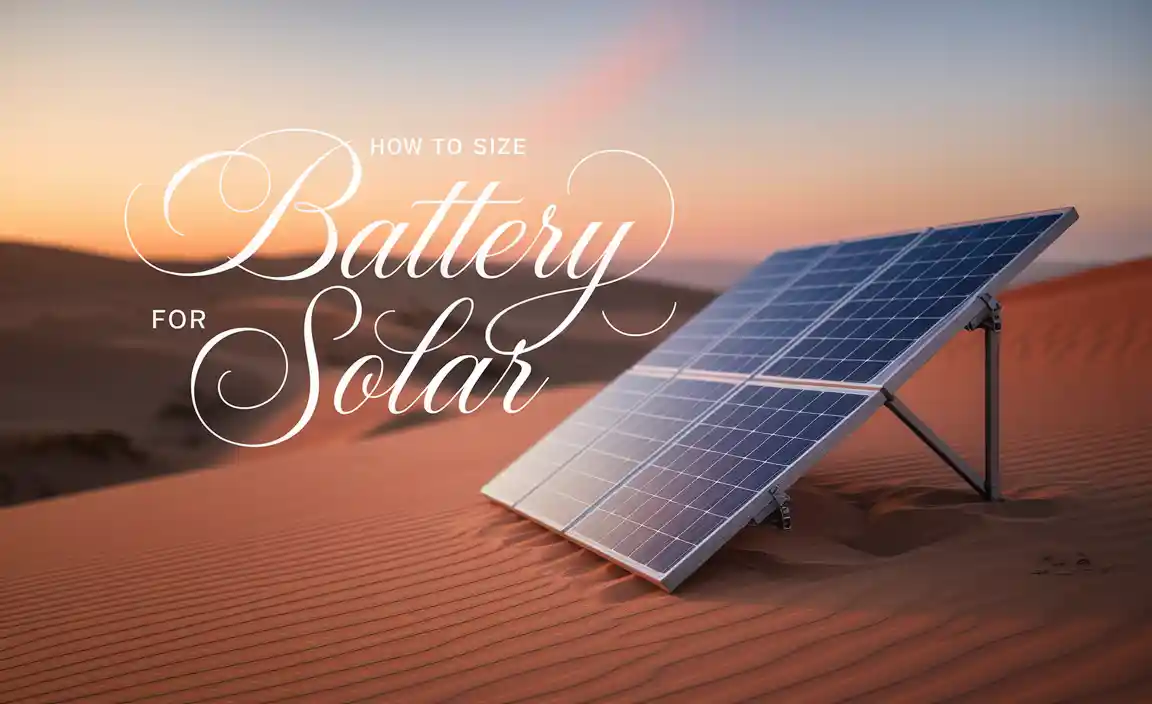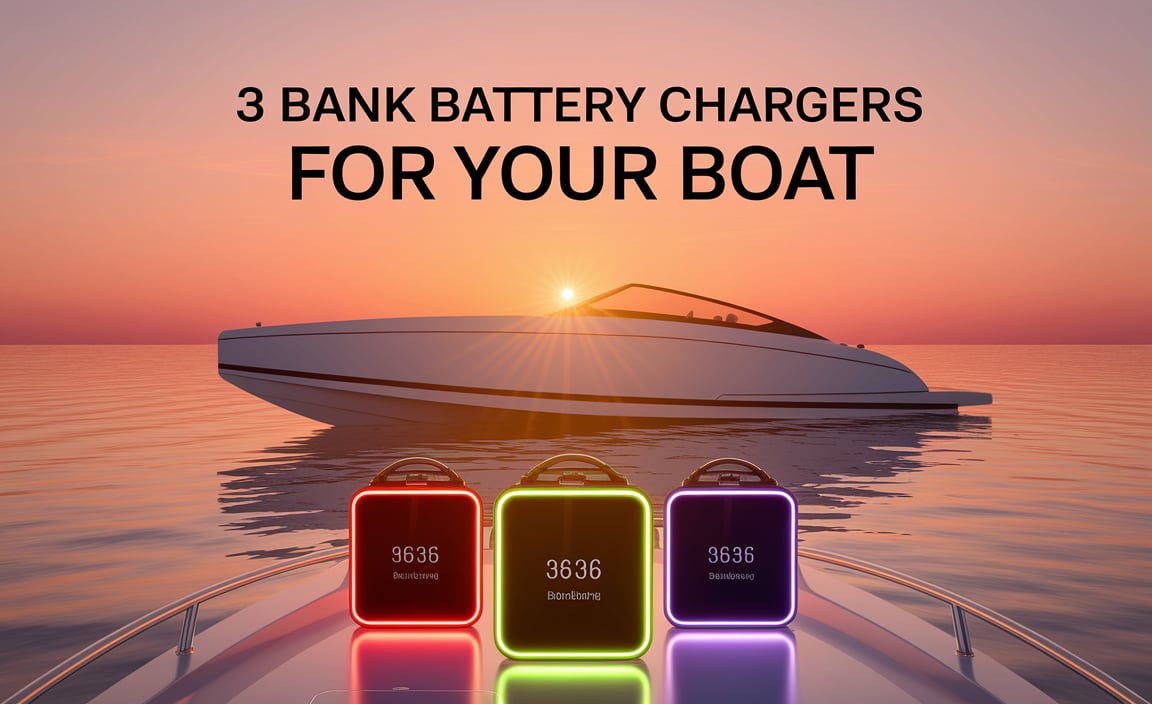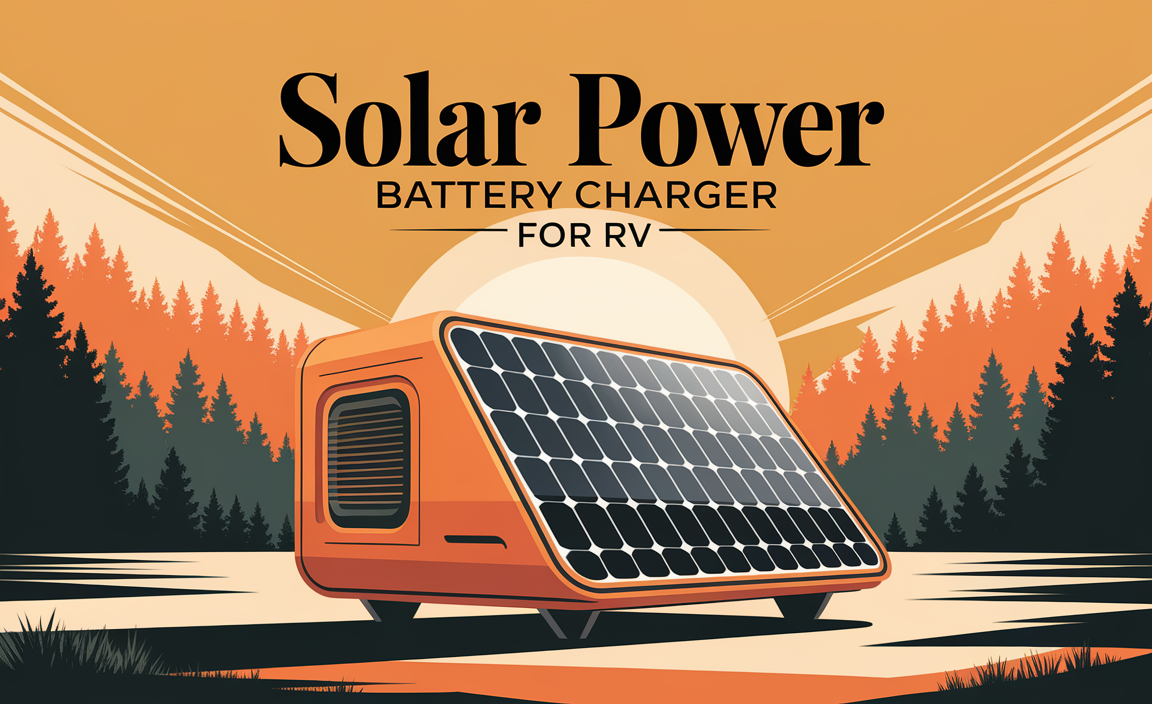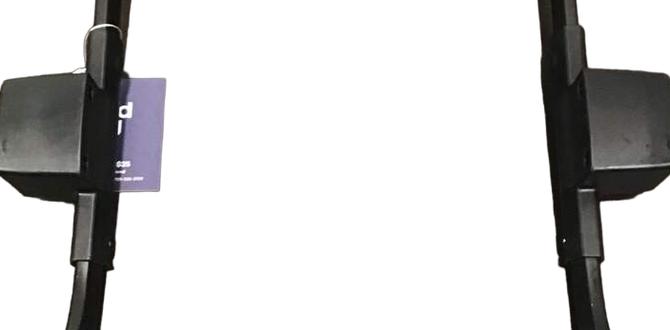Have you ever wondered how solar panels turn sunlight into power? Many people dream of going solar. But there’s one key part often overlooked: the battery. Choosing the right battery ensures you keep your lights on, even when the sun goes down.
Imagine a sunny day. Your solar panels soak up the sun’s energy. But what happens at night? This is where the battery comes in. It stores extra energy so you can use it later. However, not all batteries are the same. Sizing your battery properly is crucial for your solar setup.

Did you know that a wrongly sized battery can lead to wasted power? If it’s too small, you won’t have enough energy at night. If it’s too big, you might spend more money than needed. Finding the right size helps you save money and make the most of your energy.
Ready to dive in? Let’s explore how to size a battery for solar energy! It’s a journey that can lead to a brighter, more sustainable future.
How To Size Battery For Solar: A Comprehensive Guide
Choosing the right battery for your solar system is essential. Start by calculating your energy needs using watt-hours. Consider how many cloudy days you might experience. Did you know that a well-sized battery can store enough energy to keep your lights on during a power outage? Aim for a battery capacity that covers your use, ensuring your solar setup runs efficiently. Understanding these basics can help you enjoy a more reliable and sustainable energy source.
Understanding Battery Capacity
Explanation of amphour (Ah) and watthour (Wh) ratings. Importance of depth of discharge (DoD) for battery longevity.
Battery capacity can get a bit tricky, but it’s all about Ah and Wh. The amphour (Ah) rating tells you how much electricity the battery holds, while the watthour (Wh) rating shows how long it can power something. Think of it like a big pizza: Ah is the size of the pizza, and Wh tells you how many slices you can eat in a day!
Next up is the depth of discharge (DoD). This means how low you can let the battery charge drop without causing damage. Going too low is like taking a plunge off a diving board—fun at first, but it can hurt later! Keeping your DoD in check helps your battery live longer and serve you better.
| Battery Terminology | Definition |
|---|---|
| Ah | How much electricity it holds. |
| Wh | Duration of power supply. |
| DoD | How low you can drain your battery safely. |
Assessing Your Energy Needs
Steps to calculate daily energy consumption. Factors influencing energy use: appliances, usage times, and seasonality.
To find out how much energy you use each day, start by writing down your appliances. List the watts each appliance uses. Then, check how many hours each appliance runs daily. Use this formula: Daily Consumption (Wh) = Watts × Hours. Seasonality also matters; heating or cooling can change your energy needs. Think about:
- Appliances: What do you use?
- Usage Times: How long do you use them?
- Seasonality: Does your need change with the seasons?
Understanding these basics helps size your solar battery correctly.
How do I calculate my daily energy consumption?
To calculate your daily energy consumption, list each item’s watts and use them for about how many hours you run them. Then, multiply to find total usage. This helps you see where your energy goes.
Evaluating Solar Panel Output
How to determine the capacity of solar panels. Seasonal variations in solar energy generation.
To find the right size of solar panels, first, check how much energy they produce. Count the watts each panel gives. Multiply that by the number of sunny hours your area gets. Are there seasons when the sun plays hide and seek? Yes! In winter, energy may drop. Always plan for those fewer sunny days! Remember, doing the math now means happy solar energy later. And no, using an abacus isn’t required; your calculator will do just fine!
| Season | Average Sunny Hours | Energy Production Potential |
|---|---|---|
| Spring | 8 | High |
| Summer | 10 | Very High |
| Fall | 7 | Medium |
| Winter | 4 | Low |
After evaluating the output, adjust your battery size. A larger battery helps store extra energy from summer for those gloomy winter days. Planning ahead makes you the solar superhero!

Choosing the Right Battery Type
Comparison of leadacid vs. lithiumion batteries. Pros and cons of different battery technologies in solar systems.
When choosing a battery for solar power, there are two main types: lead-acid and lithium-ion. Lead-acid batteries are cheaper, but they need more maintenance and last less time. Lithium-ion batteries work better and last longer, but they cost more. Here’s a quick breakdown:
- Lead-Acid:
- Pros: Lower cost.
- Cons: Heavy and shorter lifespan.
- Lithium-Ion:
- Pros: Longer life and more efficient.
- Cons: Higher price.
Consider what you need. If you want a longer-lasting battery, lithium-ion is the way to go.
What should I consider when choosing a battery type?
Think about cost, lifespan, and efficiency. Different batteries serve different needs, so choose wisely!
Calculating the Required Battery Size
Formular for sizing batteries based on daily energy needs and solar panel output. Realworld examples and case studies for practical understanding.
To determine how big your solar battery should be, you need to know two things: your daily energy use and the output from your solar panels. Start by adding up your daily energy needs in kilowatt-hours (kWh). Next, see how much energy your solar panels can produce. Here’s a handy formula: Battery Size (kWh) = Daily Energy Needs (kWh) / Solar Panel Output (kWh). For example, if your home needs 10 kWh and your panels produce 5 kWh, you’ll need a 2 kWh battery size.
| Daily Energy Needs (kWh) | Solar Panel Output (kWh) | Required Battery Size (kWh) |
|---|---|---|
| 10 | 5 | 2 |
| 15 | 3 | 5 |
Thinking of solar, but don’t want to get lost in numbers? Fret not! This simple math can help you light up your home with a smile. That’s right, no calculators required—unless you want to impress your friends!
Considerations for Battery Efficiency
Factors affecting battery performance: temperature, charge cycles, and maintenance. How to optimize battery usage for solar systems.
Battery performance can be a rollercoaster ride! Key factors like temperature, charge cycles, and maintenance play big roles. For example, too much heat can turn your battery into a sleepy turtle. Aim for a comfortable temperature to keep it happy! Regular charge cycles, like a workout routine, help your battery stay fit. Plus, a little maintenance goes a long way—like brushing your teeth. That will keep everything running smoothly!
| Factor | Effect on Battery |
|---|---|
| Temperature | High heat can damage battery life |
| Charge Cycles | More cycles can improve efficiency |
| Maintenance | Regular checks boost performance |
Optimize your battery by keeping it cool, charging regularly, and giving it some TLC. Treat it like a sunflower—water it, and watch it bloom!

Common Mistakes to Avoid
Miscalculating energy needs and battery size. Overlooking system efficiency and battery management systems.
Sizing your solar battery isn’t a game of pin-the-tail-on-the-donkey! One huge mistake is miscalculating your energy needs. If you guess wrong, your battery might fizzle out like a soggy firework. Another blunder is ignoring system efficiency, which can make your battery life short-lived. Lastly, not using battery management systems is like driving a car without brakes—risky and dangerous! So, plan carefully!
| Common Mistakes | Why to Avoid |
|---|---|
| Miscalculating Energy Needs | Leads to dead batteries and wasted resources. |
| Overlooking System Efficiency | Reduces battery life and performance. |
| Neglecting Battery Management Systems | Increases risk of damage and fire hazards. |
Future-Proofing Your Solar Battery System
Planning for energy expansion: adding more panels or batteries. Understanding advancements in battery technology and trends in the solar industry.
Planning for future energy needs is smart. As your energy use grows, you might want more solar panels or batteries. New battery technology is always coming out. This can help you store more energy. Keep an eye on trends in solar power. You might find options that save money and boost efficiency.
- Choose expandable systems for easy upgrades.
- Stay updated on battery improvements.
- Consider local solar incentives for support.

What are the key factors for futureproofing a solar battery system?
Futureproofing includes planning for extra panels, staying informed about new battery technology, and adapting to changes in your energy needs.
Conclusion
In conclusion, sizing a battery for solar power means knowing your energy needs and system capacity. First, calculate daily usage. Then, consider how much sunlight your area gets. Finally, choose a battery that suits these needs. We encourage you to explore more resources or tools to help with your solar journey. Taking these steps will lead you to a successful setup!
FAQs
What Factors Should Be Considered When Determining The Appropriate Capacity Of A Solar Battery For A Home Installation?
When choosing the right size for a solar battery, we should think about how much energy we use each day. You should also look at how much energy your solar panels make. It’s important to know how long you want the battery to last without sunlight. Lastly, think about any future needs, like adding more devices. This helps us pick the best battery!
How Can I Calculate My Daily Energy Consumption To Accurately Size A Solar Battery?
To calculate your daily energy use, start by looking at your devices. Check how much energy each device needs in watts. Then, use them for a day to see how long they run. Add all the energy used in a day together. This total will help you choose the right size for your solar battery.
What Is The Difference Between Battery Capacity (Ah Or Wh) And The Solar Panel Output When Sizing A Battery System?
Battery capacity tells us how much energy a battery can store. We measure it in Amp-hours (Ah) or Watt-hours (Wh). Solar panel output shows how much energy the panels can create from sunlight. When sizing a battery system, we need to match how much energy the panels produce with how much the battery can hold. This way, we ensure we have enough power for our needs.
How Do Different Battery Chemistries (Like Lithium-Ion Vs. Lead-Acid) Affect The Sizing And Performance Of Solar Battery Systems?
Different battery types, like lithium-ion and lead-acid, have unique strengths. Lithium-ion batteries are smaller and store more energy, so we can fit more in a small space. They also work better in different temperatures. Lead-acid batteries are bigger and heavier, so they take up more room. Because of this, the size and performance of our solar battery systems can change based on the battery we choose.
What Role Do Backup Power Needs And Autonomous Operation Play In Determining The Size Of A Solar Battery Bank?
Backup power needs help us decide how much energy we need to store. If the power goes out, we want enough battery to keep things running. Autonomous operation means the system can work by itself without help. Together, these needs help us figure out the right size for the battery bank. The bigger the needs, the larger the battery bank should be!
{“@context”:”https://schema.org”,”@type”: “FAQPage”,”mainEntity”:[{“@type”: “Question”,”name”: “What Factors Should Be Considered When Determining The Appropriate Capacity Of A Solar Battery For A Home Installation? “,”acceptedAnswer”: {“@type”: “Answer”,”text”: “When choosing the right size for a solar battery, we should think about how much energy we use each day. You should also look at how much energy your solar panels make. It’s important to know how long you want the battery to last without sunlight. Lastly, think about any future needs, like adding more devices. This helps us pick the best battery!”}},{“@type”: “Question”,”name”: “How Can I Calculate My Daily Energy Consumption To Accurately Size A Solar Battery? “,”acceptedAnswer”: {“@type”: “Answer”,”text”: “To calculate your daily energy use, start by looking at your devices. Check how much energy each device needs in watts. Then, use them for a day to see how long they run. Add all the energy used in a day together. This total will help you choose the right size for your solar battery.”}},{“@type”: “Question”,”name”: “What Is The Difference Between Battery Capacity (Ah Or Wh) And The Solar Panel Output When Sizing A Battery System? “,”acceptedAnswer”: {“@type”: “Answer”,”text”: “Battery capacity tells us how much energy a battery can store. We measure it in Amp-hours (Ah) or Watt-hours (Wh). Solar panel output shows how much energy the panels can create from sunlight. When sizing a battery system, we need to match how much energy the panels produce with how much the battery can hold. This way, we ensure we have enough power for our needs.”}},{“@type”: “Question”,”name”: “How Do Different Battery Chemistries (Like Lithium-Ion Vs. Lead-Acid) Affect The Sizing And Performance Of Solar Battery Systems? “,”acceptedAnswer”: {“@type”: “Answer”,”text”: “Different battery types, like lithium-ion and lead-acid, have unique strengths. Lithium-ion batteries are smaller and store more energy, so we can fit more in a small space. They also work better in different temperatures. Lead-acid batteries are bigger and heavier, so they take up more room. Because of this, the size and performance of our solar battery systems can change based on the battery we choose.”}},{“@type”: “Question”,”name”: “What Role Do Backup Power Needs And Autonomous Operation Play In Determining The Size Of A Solar Battery Bank? “,”acceptedAnswer”: {“@type”: “Answer”,”text”: “Backup power needs help us decide how much energy we need to store. If the power goes out, we want enough battery to keep things running. Autonomous operation means the system can work by itself without help. Together, these needs help us figure out the right size for the battery bank. The bigger the needs, the larger the battery bank should be!”}}]}
Resource:
-
Understanding Depth of Discharge (DoD): https://www.energy.gov/eere/vehicles/articles/battery-depth-discharge
-
Estimating Your Home’s Energy Use: https://www.energy.gov/energysaver/estimating-appliance-and-home-electronic-energy-use
-
Battery Efficiency and Climate Impact: https://www.nrel.gov/news/program/2022/battery-performance-in-different-climates.html
-
Latest Solar Battery Trends & Technologies: https://www.greentechmedia.com/articles/read/whats-next-in-solar-storage







